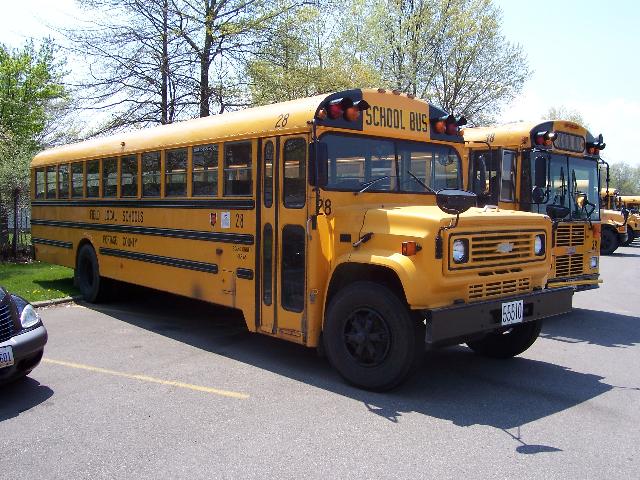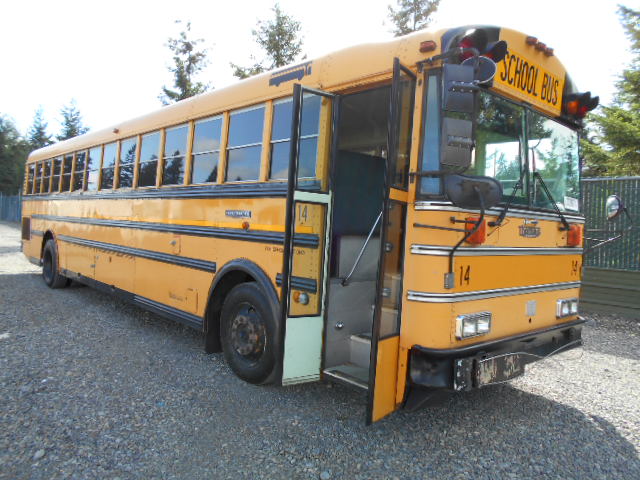Now that school is in session, Bowling Green is filled to the brim with school busses ferrying kids across town and cops monitoring school zones. Since I live far enough away from the city that I’m not too bothered by bus traffic (not having a commute in the morning certainly helps!) I normally don’t pay too much attention to a school bus that isn’t stopped and flashing lights. But as I was driving home from running some errands, I got to see the middle school’s parking lot filled to the brim with busses: conventional Blue Bird busses, semi-conventional Freightliner/Thomas busses, and the one Chevrolet Savana-based short bus. The local district uses several chassis lengths, and are in the middle of trying out some fuel-saving models, easily identifiable by the obnoxious “HYBRID” lettering on the forward roof.
But that got me thinking: it’s been fifteen years since I graduated high school, seventeen years since I last rode a school bus, and twenty-seven years since I first rode the bus. And oddly enough, in that time frame, and with all of the schools I attended over those years, I only rode three types of bus ever. The first bus, #21, was an older Chevrolet C-series conventional in southern Illinois. The heater didn’t work for beans, the air-conditioning was nonexistent (that’s what the windows are for!) and in-between lurching starts, scary stops, and the one incident that involved a Chevy Beretta not paying attention, I can’t say that it was my favorite.
When I moved up to Washington State in 1993, I got introduced to the “twinkie” style of bus. Ok, it is technically a “streamliner” bus, but give me a break: they were Twinkies. They were long, yellow, and usually filled with white. And the most common Twinkie bus around was the Gillig Transit Coach school bus. South Kitsap School District #402 had to have nearly a hundred of these beasts, plus a couple of Crown coaches and the tiny handful of fairly newer Thomas Safe-T-Liner style brick busses on hand.
The Thomases were quiet and smooth. The Crowns, all of which dated to the late 1950s, were a full-fledged assault on your senses. The Gilligs were also a full-on assault on your senses. We changed busses pretty much every year we were there, but the fleet ran from an oldest of 1959 to the newest Gillig I can remember, a 1978 model. All but maybe two were manual trans, all were painfully slow, and with a route time of an hour from school to home once I started middle school, I developed an iron ass…not because I particularly wanted to, but sitting on two slabs of metal with military-grade vinyl draped over it tempered me to long distances on ANY other surface.
Since I know I’m at the younger end of the scale of BangShift readership, I’m very curious to see the answers here: what kind of school bus hauled you to and from the classroom?


























BMT…What about “Blue Birds” ??? Blue Bird American also produces the “Wanderlodge”.
International with a standard shift no radio or A/C or seat belts and the driver smoked every single day we got on .
A Jet School Bus ?
As we had no dedicated school buses here in the UK I had to put up with a fume-belching chronically slow Leyland double-decker. But that was only on rainy days as I lived within easy walking distance of my school!
How I wished for a classic big yellow….
International Loadstar 1600. One driver apparently never learned to drive a manual transmission. If you can’t find ’em grind ’em.
“They’re coming out with rubber gears next year!”
A bicycle, up hill both ways too. We had one gear AND WERE HAPPY FOR IT!
Now get off my lawn McSquatch.
up hill both ways for me also and on a dirt road
Early 70’s Ford B600 with Wayne body. #29. No air so when you start school
in August in GA, it was a roaster on the way home in the afternoon. Our driver had trouble with a manual so when she would look for second, we would all yell, ” If you can’t find it, grind it!”!
Reo Speedwagon and then a 1954 Blue bird, a gas pusher that the transmission linkage malfunctioned quite often.
In the 70s we were in the 2nd poorest school district in the state of Colorado & we had nothing but gas powered (read “underpowered”) Fords & Internationals (no diesels at all) that often had to be pushed the last hundred feet or so over passes by the football team. We had no travel buses, so on “away” game days another bus would have to run multiple routes to cover for our “game” bus’s route.
They were crowded, overused & underpowered. Long road trips were miserable–either too hot or freezing. There was no cargo area so equipment was either stuffed under the seat (if it fit) or piled in the back few seats or tossed in the back of a coach’s pick-up if the weather was decent.
There was no doubt our teams’ performance suffered b/c of the crappy buses. We’d have to arrive early just to work the kinks out of riding on the cramped bus. I felt sorry for the really big guys. They had to be even more miserable. Best thing that could happen to you would be to ride home after a game or tourney with a parent or friend’s parent, but sometimes we’d choose to stay with the team for the sake of the rest of the players. Other times we’d ride home with parents so those stuck on the bus would have more room, particularly if it was a long drive.
We seriously envied the schools who had the “luxury” Blue Birds.
Crown Super Coaches all the way. In kindergarten it was about a ’66 model, number 8 and the driver was named Dan. He would pick one kid every day who got to pick what AM radio station we would all get to listen to on the way to school. This was 1969, so lots of good tunes.